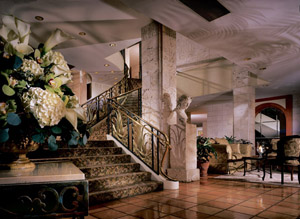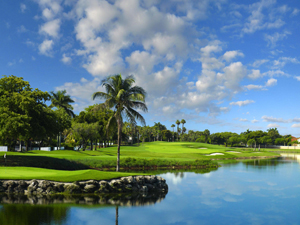Featured Golf News
Doral: More Relevant that Ever
It's not just the talent than waxes and wanes on the PGA Tour, the tournaments themselves ebb and flow in terms of relevance and importance.

No. 10 at the Blue Monster
Some examples: While their namesake hosts were alive, the Bob Hope Classic and Byron Nelson Championship would draw reasonably deep fields. Now, both events struggle to attract marquee names. For more than 25 years, Hilton Head's Heritage Tournament was slotted the week after the Masters, and would consistently draw an intriguing international field, often crowning a prominent player as champion.
But it's been a fairly rapid slide for those events in the last decade. Heritage's diminution as an upper-tier Tour event - hastened in part by the advent of the World Golf Championships - continues, and this spring's version will not follow the goings-on at Augusta for the first time since 1983 as it's been pushed back an additional week.
The Doral Resort in Miami, a longtime PGA Tour venue, has been there and back, having experienced both sides of this spectrum. Dating back almost 50 years, the event, in all its name iterations, was for years considered the "unofficial" start of the PGA Tour season, because when the Tour reached Florida in springtime the distant drumbeat of Augusta was getting louder and closer. It's arguable that the event's ultimate heyday was the early-to-middle '90s, when the charismatic Greg Norman won three times, sandwiched around victories by other Hall-of- Fame players like Nick Faldo and Ray Floyd. But then the heretofore moribund West Coast Swing preceding Doral regained momentum and importance, and the Miami event lost some luster.
But the re-branding of Doral as a World Golf Championship venue in 2007 recast its fortunes. And with victories by Tiger Woods, Geoff Ogilvy, Phil Mickelson and Ernie Els in its first four iterations as a WGC event, Doral's star remains on the rise. Yet there is much more to Doral than the famed Blue Monster Course, among the 90 holes on property. As the resort celebrates its 50th anniversary, major renovations of many amenities have been completed. Sixteen million dollars is the most recent renovation outlay, and all told the Marriott Corporation has sunk $100 million into the 650-acre resort since it took over in 2004.

The Entry to Doral's Spa
A recent long-weekend visit to Doral with my wife and college-age daughters proved that, even half-a-century after it's founding, Miami's best-known golf resort remains relevant for all sorts of reasons. We occupied connecting ground-floor accommodations among the nearly 700 rooms and suites on property, and they were spacious, contemporary, and from our modest patios in particular, featured long views of the expansive lawns abutting the Blue Monster's famous 18th green. But we weren't hanging around the rooms for long.
The gym is both massive and modern; there are plenty of upscale shops, a variety of pools for swimming and sunning, and eateries throughout, none better than Mesazul. Spanish for "blue table," Mesazul offers a modern-day Latin-inspired spin on a classic American steakhouse. The 160-seat restaurant also features panoramic views of the Blue Monster.
There's probably not a lot of steak on the menu next door at the renowned Pritikin Longevity Center & Spa, which opened adjacent to Doral's Spa late in 2009. Established in 1975, Pritikin is the longest running, most successful residential program of heart health, nutrition and fitness in the United States.

The Blue Monster Has Water Aplenty
Cardiac health is an imperative when facing some of the demanding shots required to play the resort's signature golf course, the fabled Blue Monster. Certainly one of the most memorable golf shots of the last 10 years was authored there by Australia's Craig Parry, who holed out a 6-iron on the 72nd hole for an improbable eagle to capture what was then known as the Ford Championship back in 2004. The rest of us can only dream of making a three, be happy with a four and, for most players, not unsatisfied with a bogey five. The famous 18th, with its signature fountain, ranked by Golf Magazine as one of the "Top 100 Holes in the World," is that tough.
Originally designed by Dick Wilson, over the past few decades the course has been modified and updated to challenge the skill set of PGA Tour players by one of their own - three-time Doral champion Ray Floyd. At more than 7,200 yards, well-bunkered and encircled by deep Bermuda rough, length off the tee and a deft short game are key ingredients to success. (The proof is in the power quartet of recent WGC champions at Doral, as outlined in paragraph three - holders of 22 major titles between them.)

3rd Hole at Doral's White
Like Floyd, Norman is a three-time winner at Doral. Memories of his last victory 15 years ago are long faded, but his presence lives on thanks to his architectural acumen. His Great White Course is the second option on property, and is one of the few courses in the Southeast that utilizes coquina sand, which is basically crushed shells, as the primary design element on every hole. Norman narrowed the fairways by planting hundreds of palm trees, and water comes into play on 14 of the 18 holes. Woods, water and coquina wasteland are three-fourths of the challenge.
The last part of the equation is the relatively constant distraction of planes arriving at the International Airport, less than 10 miles away, as their flight path practically casts shadows on many of the Great White's fairways. But despite the noisy intrusions, the course is still an eminently worthwhile venue.

A View of Jim McLean's Course
While options one and two are easily accessible from the hotel and pro shop, the Jim McLean Signature Course necessitates a 10-minute shuttle ride off the resort. This is small-time intrusion in the overall scheme of things, because the course, named for the renowned on-site swing guru, presents a variety of challenges that include three of the toughest starting holes in the state, a memorable quartet of par-3s, and the feared "Bermuda Triangle" of holes 13 through 15. Five sets of tees afford plenty of playing flexibility for those who break par, those who break clubs, and all levels in between.
Rounding out the golf offerings are the Gold and Red Courses, both simpler and less daunting tests than Doral's "Big Three" but not exactly toothless. The former, which boasts an island green on its final hole, hosted the 1999 PGA Qualifying School finals. The latter is pint-sized at less than 6,100 yards from the tips, but with 14 water-laden holes winding around several lakes, it was staunch enough to attract the LPGA in 2001 for the Office Depot Championship.
No matter what course or combination of golf options one chooses, the resort has retained its relevance for a half-century. It doesn't take consecutive tours of the Red, White and Blue Monster to realize that Doral is as full-bodied and All-American as any big-time golf resort in the Southeast.
For more information, visit www.doralresort.com.
Joel Zuckerman, called "One of the Southeast's most respected and sought-after golf writers" by Golfer's Guide Magazine, is an award-winning travel writer based in Savannah, Ga., and Park City, Utah. He has written five books, including the epic "Pete Dye Golf Courses" in 2008. Joel's course reviews, player profiles, essays and features have appeared in more that 100 publications internationally, including Sports Illustrated, Golf, Continental Magazine, Travel & Leisure Golf, Sky Magazine, Golf Connoisseur, Golfweek, Estates West, Millionaire and Golf International. For more of Joel, visit www.vagabondgolfer.com.
Story Options
 |
Print this Story |
